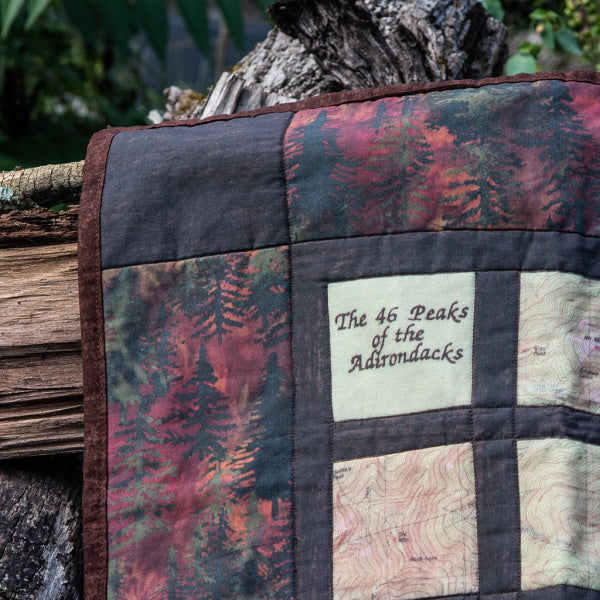Shop Adirondack 46er Topo Quilt >>
For most of us, the concept of creation is binary. Arts and crafts are either made using ancient techniques or post-Millennial tech. But can it be both at the same time?
Susan Rivers argues it can. Rivers grew up in the Bronx playing and creating with fabric as far back as she can recall, but she was also fascinated by science and technology. She worked for decades as an urban, environmental planner, and never felt that her love of art should — or in her case, could — be separated with her deep affinity for technology and science.
She has found a beautiful way to merge science and art through her company, Greentree Fiber Arts, and in recent years, has added additional layers of complexity, nuance, and compassion to the craft she has been practicing practically almost since the cradle, quilting. Please read on to learn more about River’s journey.
NEW YORK MAKERS: I’d love to hear about how you got your start as a quilter.
SUSAN RIVERS: One of my grandfathers, Henry Leo Grunbaum, worked in the Garment District in New York City, and he’d bring home swatches of sample fabrics that I began hoarding. Before I could even use scissors or operate a sewing machine, I was designing ponchos and clothes for my Barbie, and laying fabrics next to each other for quilt designs. I was obsessed with the fabrics and colors, the looks, the textures, everything. Then as soon as I could get a sewing machine, I did, and I began designing and creating quilts. My company, Greentree, is named after my grandfather because in German, Grunbaum means “Greentree.”

Susan Rivers of Greentree Fiber Arts
NYM: But you’re also very clearly a science wonk. How did that happen and evolve?
SR: My other grandfather was a pharmacist. He would let me come in and help out, and, in those days, you would work on grinding up pills with a mortar and pestle. I was fascinated by the process, and became interested in science. I went to PS 109 and then the Bronx High School of Science, then SUNY Binghamton and Rensselaer Polytechnic Institute. Then I went to work for FEMA as an urban and environmental planner, but I never gave up quilting. Then, when I retired a few years ago, I began focusing on it full-time.
NYM: How did you intellectually merge science and art into quilting?
SR: I’ve always looked at quilting and the fabric arts as more than the sum of their parts. It’s not just material sewn together, it’s a personal and aesthetic expression of joy, a celebration, a meditation, an appreciation, and -- more and more for me -- an exercise in memorial. Because I’ve always been computer literate and absolutely love New York and the great outdoors, I’ve been using the topography of New York to create quilts and pillows. I think of it as quilted alchemy.
NYM: How does it work in practice?
SR: I started by using my own computer printer, and using photographs and topographic maps, but now I outsource that part and sew together all of the elements by hand, once I have the printed fabric. I’ve been focusing on pillows and lap-quilts, about 40 by 40 inches, with the 46 High Peaks of the Adirondacks and the 12 highest peaks of the Catskills. I’ve also been creating face masks in honor of the late Supreme Court Justice Ruth Bader Ginsberg, but I’ve really been delving into work in honor of my late friends, so that their legacy can live on.


NYM: I’d be very curious to hear more about your work memorializing friends.
SR: My first fabric memoir project was with my friend Norma’s child Ryan, who was diagnosed with cancer at age 4. I made a quilt for Ryan that incorporated photos of his family and friends and favorite characters, and he used it in the hospital and at home. That was 2004, and it evolved into a project called Comfort Quilts. I make them by design for sick children, some of whom take pictures of what they miss, plus photos of friends and family, which I incorporate into quilts with matching pillow cases. I also create a photo album. Each project is distinct, just like the people I work with. I also have friends that are artists who, when they’re sick or elderly, tell me that they want me to memorialize their work. It’s incredible because, after they pass, it’s like we’re still collaborating. It’s really a gift for me in many ways. Right now, I’m working on a project for a friend whose husband passed, and I play music that they listened to as I work with his clothes, creating a quilt. It’s an incredible experience, very emotional, but also cathartic.
NYM: How has the pandemic changed the way you work?
SR: Before the pandemic, I worked out of a gallery in the Shirt Factory in Glens Falls. But it’s not practical now, so I closed the gallery and work from home. In isolation I have blossomed in many ways. I miss my neighbors, but I’m so busy; and I feel like I’m taking my art to places I may not have dared take it before all of this happened. It has been a terrible time, but also an opportunity for reflection and renewal.

Pre-pandemic home of Greentree Fiber Arts in Glens Fall, NY
Rivers, of course, isn’t alone. The pandemic has changed everything about how we live and work. As a New Year dawns with the promise of vaccines to inoculate against Covid-19, I think we’re all breathing a little easier, with hope for the future, and, if we’re lucky, a new sense of who we are and of what we are capable.


Leave a comment